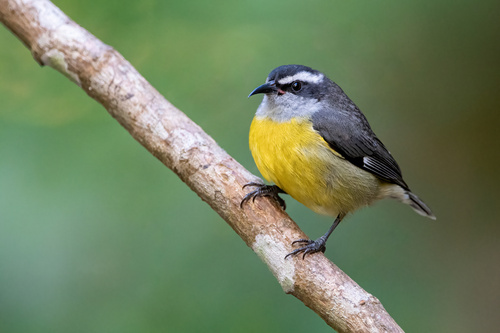
Bananaquit
The Bananaquit (*Coereba flaveola*) is a small, active, nectar-feeding bird found throughout the tropical Americas, excluding Chile and most of Argentina. It's recognized for its downcurved bill, bright yellow underparts (in most subspecies), and black and white head markings. This adaptable species thrives in a variety of habitats, from gardens and scrubland to forest edges, playing a vital role in pollination. While not considered a songbird, its high-pitched calls and constant activity make it a conspicuous presence. Culturally, it's often associated with gardens and is sometimes even kept as a cage bird, though this practice is discouraged due to its wild nature.
10-13 cm
Length
15-18 cm
Wingspan
Least Concern
Conservation Status
Distribution
The Bananaquit is native to tropical South America, Central America, Mexico, the Caribbean, and has a small presence in southern Florida (primarily introduced populations). It ranges from southern Mexico south to northern Argentina and Uruguay. It does not migrate significantly, though some local movements may occur in response to food availability.
Lifespan
Average lifespan in the wild is not well-documented, but likely around 5-7 years. Captive individuals may live longer.
Bananaquit's Habitat
Habitat Types
Forest edges, Woodlands, Gardens, Scrubland, Cultivated areas, Secondary growth
Climate Zones
Tropical, Subtropical
Adaptations
The Bananaquit's downcurved bill is a key adaptation for accessing nectar from a wide variety of flowers. Its small size and agility allow it to navigate dense vegetation. It also displays a high tolerance for human-modified habitats.
Variations
There are numerous recognized subspecies (over 40) of Bananaquit, differing primarily in plumage coloration, particularly the darkness of the throat (ranging from white to black) and the presence or absence of a white spot on the wing. Island populations often exhibit distinct variations.
Appearance
Breeding Plumage
Plumage is generally consistent year-round, with no significant differences between breeding and non-breeding seasons.
Seasonal Feather Changes
No significant seasonal variations.
Sex Based Plumage Differences
Males and females are generally similar in appearance, though males may have slightly brighter yellow underparts in some subspecies.
Notable Features
Downcurved bill, Black crown and back, Bright yellow underparts (in most subspecies), White supercilium (eyebrow stripe), White wing spot (variable in size and presence)
Diet and Feeding
Primary Foods
Nectar, Small fruits, Insects, Spiders
Foraging Behavior
Bananaquits are active foragers, flitting quickly between flowers and branches. They pierce the base of flowers to access nectar, often bypassing the normal pollination mechanism. They also glean insects and spiders from foliage.
Specializations
The downcurved bill and specialized tongue (brush-tipped and slightly tubular) are adapted for nectar feeding. They can also pierce fruits to access juices.
Seasonal Diet Variations
While nectar is a year-round food source, the proportion of insects and fruits in the diet may increase during periods of lower flower availability.
Behavior
Social Structure
Bananaquits are generally solitary or found in pairs, but they may form small, loose flocks outside of the breeding season, particularly around abundant food sources.
Communication
High-pitched, thin calls, Rapid wing fluttering (during courtship and territorial displays), Short, buzzy songs
Migration
Bananaquits are largely non-migratory, but may undertake local movements in response to food availability. They are resident birds.
Territorial or Group Behaviors
During the breeding season, males defend small territories around nesting sites. Outside of breeding, they are less territorial and may forage in mixed-species flocks.
Conservation
Threats
Habitat loss (deforestation and urbanization), Pesticide use (affecting insect prey), Capture for the pet trade (in some regions)
Protection Programs
Not specifically targeted by major conservation programs due to their widespread distribution and adaptability.
Local National Laws
Protected under general bird protection laws in many countries within its range.
Population Trend
Stable
Population Estimates
Population is considered widespread and abundant; specific global estimates are difficult to obtain, but it is not considered threatened.
Interesting Facts
Bananaquits are known to 'steal' nectar
They often pierce the base of flowers to access nectar, bypassing the pollination process that would normally occur if they entered the flower from the front.
They have a high metabolic rate
Their active lifestyle and nectar-based diet require a high energy intake and rapid metabolism.
They are highly adaptable
Bananaquits thrive in a wide range of habitats, including human-modified environments, which contributes to their widespread distribution.
They are sometimes called 'sugar birds'
This nickname reflects their strong preference for sweet, sugary substances, including nectar and fruit juices.
Faqs about Bananaquit
Are Bananaquits related to bananas?
The name 'Bananaquit' is likely derived from their frequent visits to banana plantations, where they feed on nectar from banana flowers and may also consume overripe fruit. They are not directly related to the banana plant itself.
Do Bananaquits make good pets?
While sometimes kept as cage birds, Bananaquits are wild animals with specific dietary and behavioral needs that are difficult to meet in captivity. It is generally recommended to enjoy them in their natural habitat.
How many subspecies of Bananaquits are there?
There are over 40 recognized subspecies of Bananaquits, differing in plumage coloration and distribution.
How can I attract Bananaquits to my garden?
Planting flowering plants that produce nectar, such as hibiscus, salvia, and bougainvillea, can attract Bananaquits. Providing a source of fresh water, like a bird bath, can also be helpful.
Copyright @ Nature Style Limited. All Rights Reserved.
 English
English